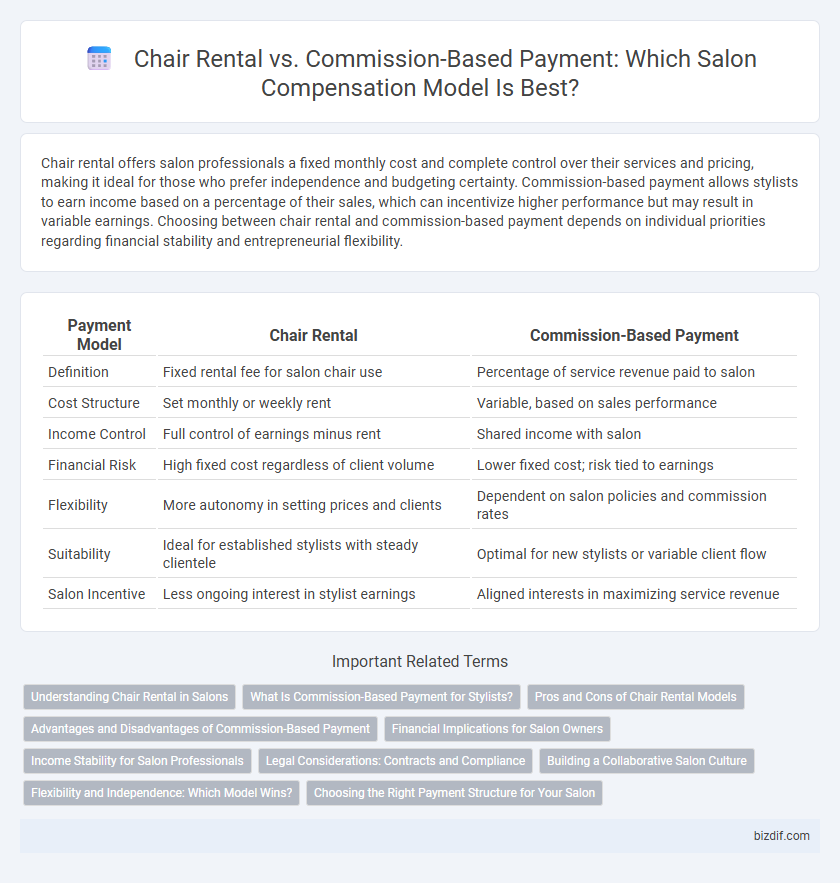Chair rental offers salon professionals a fixed monthly cost and complete control over their services and pricing, making it ideal for those who prefer independence and budgeting certainty. Commission-based payment allows stylists to earn income based on a percentage of their sales, which can incentivize higher performance but may result in variable earnings. Choosing between chair rental and commission-based payment depends on individual priorities regarding financial stability and entrepreneurial flexibility.
Table of Comparison
| Payment Model | Chair Rental | Commission-Based Payment |
|---|---|---|
| Definition | Fixed rental fee for salon chair use | Percentage of service revenue paid to salon |
| Cost Structure | Set monthly or weekly rent | Variable, based on sales performance |
| Income Control | Full control of earnings minus rent | Shared income with salon |
| Financial Risk | High fixed cost regardless of client volume | Lower fixed cost; risk tied to earnings |
| Flexibility | More autonomy in setting prices and clients | Dependent on salon policies and commission rates |
| Suitability | Ideal for established stylists with steady clientele | Optimal for new stylists or variable client flow |
| Salon Incentive | Less ongoing interest in stylist earnings | Aligned interests in maximizing service revenue |
Understanding Chair Rental in Salons
Chair rental in salons allows stylists to lease a space and operate independently, giving them control over their schedule and pricing while paying a fixed weekly or monthly fee. This model offers predictable overhead costs compared to commission-based payment, where stylists earn a percentage of their service revenue, often leading to variable income. Understanding chair rental is crucial for stylists seeking autonomy and stable expenses in managing their salon career.
What Is Commission-Based Payment for Stylists?
Commission-based payment for stylists involves earning a percentage of the revenue generated from the services they provide, typically ranging from 40% to 60% of each client's bill. This model incentivizes stylists to increase sales and client satisfaction since their income directly depends on the number and value of services performed. Unlike chair rental, where stylists pay a fixed monthly fee regardless of income, commission payments align stylist earnings with their performance and client retention.
Pros and Cons of Chair Rental Models
Chair rental in salons offers stylists control over their income with a fixed monthly fee and the freedom to set their own prices, fostering entrepreneurial growth. However, the upfront cost and responsibility for client acquisition and supply expenses can pose financial risks compared to commission-based models where revenue is shared but operational costs are lower. Stylists opting for chair rental benefit from greater autonomy but must manage business overheads, while commission-based payment systems provide financial predictability and salon support yet limit earning potential.
Advantages and Disadvantages of Commission-Based Payment
Commission-based payment in salons offers stylists the advantage of earning income directly linked to their performance, incentivizing higher productivity and customer satisfaction. However, this model can lead to income instability during slow periods, making financial planning difficult for stylists relying solely on commissions. Salons benefit from reduced fixed costs, but may face challenges in motivating consistent quality service when commissions are low or unpredictable.
Financial Implications for Salon Owners
Chair rental offers salon owners a predictable, steady income stream by charging stylists a fixed monthly fee, reducing financial risk and simplifying cash flow management. Commission-based payment aligns salon revenue with stylist performance, potentially increasing overall profit during high demand but introduces variability and requires more complex payroll processing. Evaluating local market rates, stylist experience levels, and salon size is crucial for owners to optimize profitability between these financial models.
Income Stability for Salon Professionals
Chair rental offers salon professionals a fixed monthly expense, providing predictable costs but requiring consistent client flow to ensure stable income. Commission-based payment ties earnings directly to service sales, resulting in variable income that fluctuates with client volume and sales performance. Income stability depends on individual client retention and market demand, making chair rental preferable for predictable budgeting and commission-based payment attractive for higher earning potential during peak periods.
Legal Considerations: Contracts and Compliance
Salon chair rental agreements require clear, legally binding contracts outlining terms, rental fees, and duration to ensure compliance with local business laws and tax regulations. Commission-based payment structures must adhere to employment laws, including wage standards and benefits, to avoid misclassification issues and potential legal disputes. Both models necessitate thorough documentation and regular review to maintain regulatory compliance and protect the rights of salon owners and professionals.
Building a Collaborative Salon Culture
Chair rental fosters independence and financial control for stylists, encouraging entrepreneurial spirit within the salon. Commission-based payment promotes teamwork and shared goals, as stylists are invested in the salon's overall success. Balancing these models can enhance collaboration, aligning personal ambitions with collective growth to build a supportive and dynamic salon culture.
Flexibility and Independence: Which Model Wins?
Chair rental offers hairstylists maximum flexibility and independence, allowing them to set their own hours, pricing, and client base without sharing revenue. Commission-based payment ties stylists' income to salon sales, limiting autonomy but providing a steady paycheck and potential access to salon resources and clientele. For professionals prioritizing control over their work environment and earnings, chair rental emerges as the superior model in flexibility and independence.
Choosing the Right Payment Structure for Your Salon
Choosing the right payment structure for your salon involves weighing chair rental versus commission-based payment models based on your business goals and stylist preferences. Chair rental offers fixed income stability and full control over services and pricing, ideal for experienced stylists seeking independence. Commission-based payment provides flexible earnings linked to performance, fostering motivation and teamwork while potentially driving higher revenue for the salon.
Chair rental vs Commission-based payment Infographic

 bizdif.com
bizdif.com